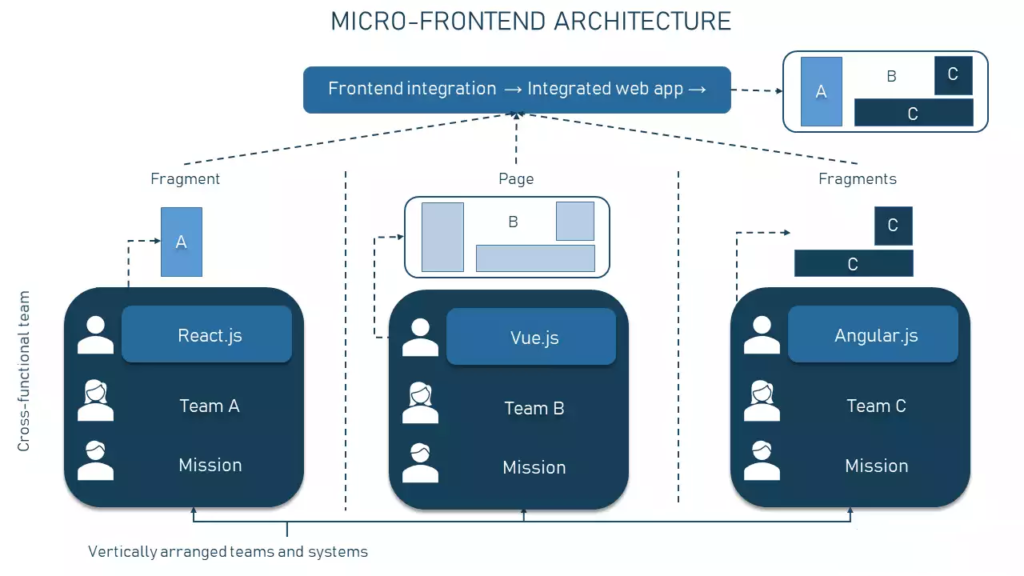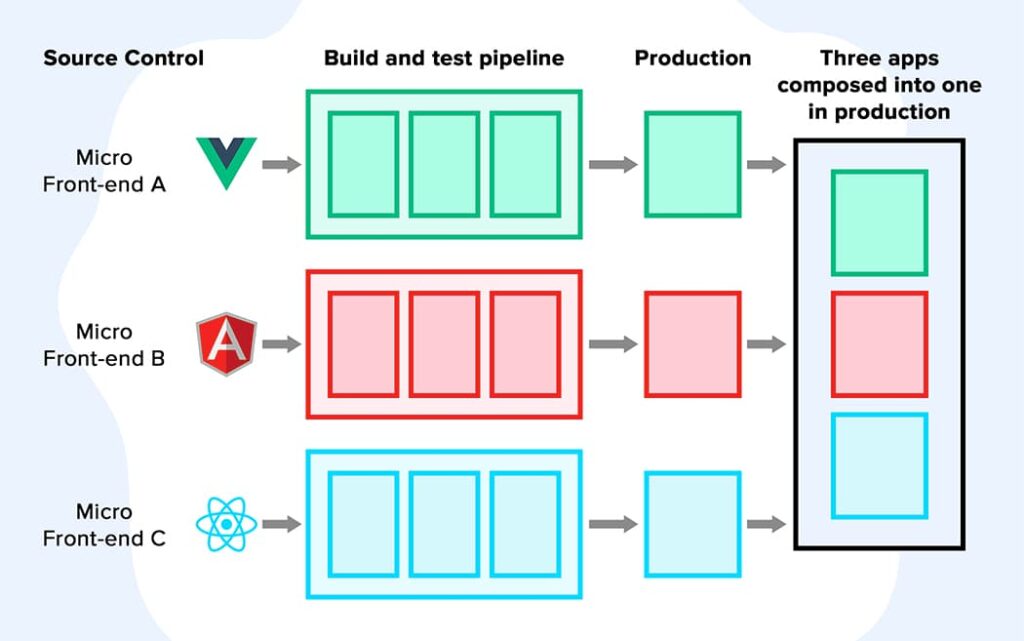Introduction
Web development has come a long way since its inception. From monolithic architectures to modular structures, the evolution has been constant. The latest trend in this evolution is the adoption of microfrontends. In this blog, we’ll explore what microfrontends are, their use cases across various domains, key principles, the challenges of the traditional approach, the advantages of microfrontends, and how you can implement them in your organization.
What is Microfrontends?
Microfrontends are an architectural approach to building web applications by breaking down the frontend into smaller, more manageable and independent pieces. In this setup, each piece, called a microfrontend, is developed and deployed separately. These microfrontends are often responsible for specific parts of the application, such as user profiles, shopping carts, or the main content, and they can be developed using different technologies or frameworks.
What is Micro-Frontend Architecture?
Micro-frontend architecture is a paradigm that extends the principles of microservices to the frontend of web applications. It involves breaking down the frontend of a web application into smaller, self-contained units called microfrontends. Each microfrontend is a standalone module responsible for a specific piece of functionality or user interface. These microfrontends can be developed independently, using different technologies and frameworks, and can be composed to create a seamless user experience.

In micro-frontend architecture, there is typically a shell or a container application that serves as the entry point for the user and orchestrates the loading and rendering of the microfrontends. This container application is responsible for managing the routing, navigation, and communication between the microfrontends
What is the Relationship Between Microfrontends and Web Components?
Web components are a standardized way of creating reusable and encapsulated components in web applications. They consist of HTML templates, custom elements, and shadow DOM, providing a clean separation of concerns and reusability. Web components offer a natural synergy with microfrontends due to their component-based nature.
The relationship between microfrontends and web components can be understood as follows:
- Component Reusability: Web components can be used as the building blocks for microfrontends. Each microfrontend can consist of a collection of web components, making it easier to develop, test, and maintain these individual modules. This promotes reusability and a clean separation of concerns.
- Isolation: Web components inherently provide isolation. When used within microfrontends, they can ensure that the styles, behaviors, and markup of one microfrontend do not interfere with others. This is essential for the independence and isolation of microfrontends.
- Interoperability: Web components can be developed using various frontend frameworks or libraries and can be seamlessly integrated into microfrontends developed using different technologies. This interoperability simplifies the integration of microfrontends within a single application.
- Flexibility: Web components are technology-agnostic, which means that microfrontends can be developed using different technologies, including different frontend frameworks (e.g., React, Angular, or Vue.js). This flexibility allows development teams to choose the tools and technologies that best suit their needs.
- Consistency: By using web components within microfrontends, you can maintain a consistent user interface and user experience across the entire application. This is particularly valuable for applications that need to deliver a unified branding and design.
In summary, web components serve as a bridge between microfrontends and the principles of component-based development. They enhance the modularity, reusability, and isolation that micro-frontend architecture seeks to achieve, while also allowing flexibility and interoperability among different microfrontends.
Use Cases in Multiple Domains
Microfrontends find applications across various domains:
- E-commerce: In an e-commerce platform, different teams can work on different parts, like product listings, recommendations, and checkout, independently. This enables agility and faster feature development.
- Content Management: Websites with extensive content can benefit from microfrontends by allowing content creators to manage and update their sections independently.
- Enterprise Applications: In large organizations, different departments can work on their respective parts of the application, simplifying development and deployment.
- Collaborative Platforms: Collaboration tools can use microfrontends for chat, video conferencing, file sharing, and other features, providing flexibility in development and scaling.
- Customer Portals: Microfrontends can be used to create customer portals with personalized views for various user segments, such as retail customers, wholesale clients, and partners.
Key Principles of Microfrontends
The key principles of microfrontends include:
- Independence: Each microfrontend should be self-contained and independent, allowing it to be developed, tested, and deployed without affecting other parts of the application.
- Decoupling: Microfrontends should be loosely coupled with the core application, enabling teams to work on them separately and with the technologies they prefer.
- Isolation: The isolation of microfrontends ensures that a failure in one does not affect the overall stability of the application.
- Composability: The ability to compose microfrontends into a complete application is a fundamental aspect, where different microfrontends can be combined to create a unified user experience
Challenges of the Traditional Approach
Before delving into the advantages of microfrontends, it’s essential to understand the challenges of the traditional monolithic approach to web development:
- Scalability: As applications grow, monolithic codebases become harder to manage, scale, and update.
- Development Bottlenecks: Teams working on different parts of the application often run into bottlenecks and dependencies on other teams.
- Version Conflicts: In monolithic applications, it’s easy for changes in one part of the code to break other parts.
- Testing Complexity: Comprehensive testing of the entire application can be time-consuming and challenging.
- Technological Limitations: Using the same technology stack for the entire application can limit innovation and hinder the adoption of new tools and frameworks.
Advantages of Microfrontends
Microfrontends offer several compelling advantages:
- Modularity: Easier development, testing, and maintenance due to smaller, focused codebases.
- Independent Deployment: Each microfrontend can be updated and deployed separately, reducing deployment bottlenecks.
- Team Autonomy: Different teams can work on different microfrontends, using the technologies they are most comfortable with.
- Scalability: Applications can scale horizontally by adding new microfrontends when needed.
- Faster Development: Faster development cycles as teams can work concurrently on various microfrontends.

Implementing it in Your Organization
To implement microfrontends in your organization, consider the following steps:
- Assessment: Evaluate your existing application and identify components that can be split into microfrontends.
- Team Organization: Organize development teams around specific microfrontends and ensure they have the autonomy they need.
- Technology Selection: Choose the right technology stack for each microfrontend, considering the team’s expertise and the task’s requirements.
- Integration: Implement mechanisms for integrating microfrontends into a cohesive application, such as an API gateway or a microfrontend shell.
- Testing and Monitoring: Establish robust testing and monitoring processes to ensure the quality and performance of each microfrontend.
- Continuous Integration/Continuous Deployment (CI/CD): Implement CI/CD pipelines for each microfrontend to streamline the deployment process.
Conclusion
Microfrontends offer a revolutionary approach to web development that empowers teams to work independently and efficiently, leading to faster development, increased flexibility, and better scalability. While it may not be the right fit for every project, the advantages of microfrontends are compelling, particularly for large and complex web applications. By adopting this approach and following best practices, your organization can stay at the forefront of web development in an ever-evolving digital landscape.
To explore how Ngenux can assist you in integrating a Micro-Frontend Architecture into your website, please reach out to us at connect@ngenux.com and engage in an informed conversation with our experienced professionals.
